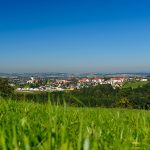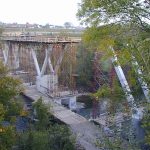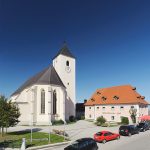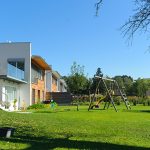Allhartsberg, Lower Austria, Austria
The rurally characterized municipality Allhartsberg is located in the district Amstetten in Lower Austria. Thus, it is at the core of the Mostviertel with its typically dispersed settlements within an attractive natural and cultural region. Allhartsberg counts 2.031 inhabitants and consists of a total area of 2.126 ha, 1.060 ha of which are grasslands, 320 ha are farmland, 600 ha are forests and 41 ha remain as settlement area.
The villages of Kröllendorf and Wallmersdorf in the northern parts of the municipality are located on the right side of the Ybbs within the alluvial land at 395 m above sea level. More than 50& of the southern municipality areas, including the main village Allhartsberg, are located within the Alpine forelands and reach heights of 700 m above sea level. Grassland management including livestock farming as well as the numerous meadows with scattered fruit trees and pear tree-lined roads characterise the region.
Allhartsberg has established itself as a municipality with very high living standards and boasts an exceptionally positive population development with a population growth of 15% over the last years.
The development of the municipality is specified in several outlines and in a local development concept and is based on openness for new things, a distinctive sense of community and the consequent socio-cultural strength as well as great commitment of the population.
The “Way of Allhartsberg” is characterised by extensive and interconnected collaboration of all clubs and institutions and leads to a visible and palpable living quality for the municipality’s inhabitants. Their visions for the future are developed by the inhabitants within the framework of the “Allhartsberg Talks”, which are guided by professional moderation and are influenced by mutual respect and appreciation.
A club house of 1.800 square meters offers the perfect conditions for all clubs, from the volunteer fire department to the music school. At its core lies an event hall with high-quality technological infrastructure. It should be mentioned that the usage of the club house does not create any costs for the municipality as it is maintained through voluntary work of the club members.
The inclusion of the youth as well as new members of the municipality is heavily promoted. The communication of values and skills that foreground the common good and joie de vivre through constant club work is of great importance. The strengthening of personal responsibility among the youth is achieved by the assignment of important communal tasks, such as the maintenance of the natural pool, and sharing the profits with the youth. The municipality also creates a framework for elderly people that allows for growing old within the family. At the “Lebenshilfe Hiesbach”, work is done for people with special needs – a work which is greatly valued.
The settlement development, based on urban building concepts and land-use plans is characterized by timely architectural solutions with low-energy standards, by orientation to the sun and by using the natural conditions of the terrain. An important factor for the positive population development is the municipality’s building plot model with space-saving and condensing settlement forms. Throughout the past 6 years, 26 new low-energy houses in contemporary design were constructed after this model. The construction of apartments in multilevel residential construction and in condensed flat-roof building with exceptional ecological quality tops off the settlement development.
Exceptional is also the renouncement of a communal construction yard. The inhabitants are responsible for their immediate surroundings and thus for the maintenance of the public and semi-public areas within the municipality. This task is accepted with great pleasure and pride. The inhabitants thereby become part of the system “municipality” and carry the resposibility for its functioning.
Only recently an ambitious and appropriate design of the church courtyard was finished as an important area for identification and communication at the core of the village.
The local supply center at the core of the village and in proximity of the town hall and the school has become a focal point of communication and customer satisfaction. Especially the range of regional organic products is used extensively by the inhabitants.
In regards to a location-appropriate means to earn a living with emphasis on a regional supply chain, the 80 agricultural businesses form an important pillar. The Ybbstaler Fruit Austria GmbH with its 175 jobs is the local leading business and deals with the refinement of cider pears – typical for the Mostviertel.
Concerning renewable energy, it should be pointed out that 145 objects – a supply percentage of 60% – are currently heated locally through the use of biomass. The hydropower plant Dorfmühle produces one megawatt hour per year. As a future project it is planned to create a civic participation programme for photovoltaik systems on all south facing roofs of public buildings.
Allhartsberg impresses with its model interconnectedness of individual measures which grow together into one great, sustainable whole contributing to the strengthening of the public welfare.
Evaluated: 2012




